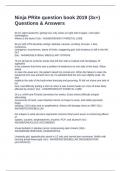Ninja PRite question book 2019 (3x+)
Questions & Answers
60 y/o right-handed M, getting lost, only writes on right half of paper. Left-sided
hemineglect.
Where is the lesion? (8x - ANSWERSRIGHT PARIETAL LOBE
66 y/o with HTN develops vertigo, diplopia, nausea, vomiting, hiccups, L face
numbness,
nystagmus, hoarseness, ataxia of limbs, staggering gait, and tendency to fall to the left.
Dx?
(8x) - ANSWERSLATERAL MEDULLARY STROKE
78 y/o pt had an ischemic stroke that left him with a residual mild hemiplegia. Pt
appeared
to be unaware that there was a problem of weakness on one side of this body. When
asked
to raise the weak arm, the patient raised his normal arm. When the failure to raise the
paralyzed arm was pointed out to pt, he admitted that the arm was slightly weak. He
also
neglects the side of the body when dressing and grooming. Pt did not shave one side of
his
face, had difficulty putting a shirt on when it was turned inside out. Area of brain likely
affected by stroke? (4x) - ANSWERSRIGHT PARIETAL LOBE
26 y.o. w/HA and R-hand clumsiness for weeks. Exam shows difficulty w/rapid
alternating
movements of hand, overt intention tremor on finger-to-nose, and mildly dysmetric
finger
tamping. CNS intact and no papilledema. Where will damage show on MRI? (5x) -
ANSWERSCEREBELLUM
DA release in what structure represents common final event assoc w reinforcing effects
of
opiates, cocaine, amphetamines, nicotine, PCP, and alcohol? (4x) -
ANSWERSNUCLEUS ACCUMBENS
Visual problem in pituitary tumor compressing optic chiasm (10x) -
ANSWERSBITEMPORAL HEMIANOPSIA
Unsteady gait, appendicular ataxia in LE only and normal eye movement. Walks with
lurching broad-based gait. (8x) - ANSWERSCEREBELLAR DEGENERATION
(ALCOHOLIC)
,Severe occipital HA, BL papilledema and no other abnormalities. Chronic acne treated
with isotretinoin. Lumbar puncture elevated opening pressure with no cells, 62 mg/dl
glucose, and 22mg/dl protein. CT is normal. (7x) - ANSWERSPSEUDOTUMOR
CEREBRI
66 y/o c/o frequent falls, several-month hx of anxiety, unwillingness to leave home. On
exam, mild impairment of vertical gaze on smooth pursuit/ saccades, mild axial rigidity &
minimal rigidity of upper extremities, along w mild slowness of movement on finger
tapping, hand opening & wrist opposition. Posture nml. Gait tentative/awkward, but w/o
shuffling, ataxia, tremor. Pt is slow in arising from a chair. Most likely dx: (7x) -
ANSWERSPROGRESSIVE SUPRANUCLEAR PALSY
79 y/o pt with a deteriorating mental state over a 3-week period has an exaggerated
startle response with violent myoclonus that is elicited by turning on the room lights,
speaking loudly, or touching the pt. Myoclonic jerks are also seen. Diagnosis: (5x) -
ANSWERSSPONGIFORM ENCEPHALOPATHY
Pt presents with a slowly progressive gait disorder, followed by impairment of mental
function, and sphincteric incontinence. No papilledema or headaches are reported.
Likely
diagnosis? (4x) - ANSWERSNORMAL PRESSURE HYDROCEPHALUS
65 y/o pt fell several times past 6 mos. MSE nml. Smooth pursuit, saccadic movements
impaired. Worse w vertical gaze. Full ROM w doll head maneuver. Mild symmetric
rigidity/bradykinesia, no tremor. MRI/CSF/labs unremarkable. Dx? (4x) -
ANSWERSPROGRESSIVE SUPRANUCLEAR PALSY
28y/o with emotional lability and impulsivity. LFT's elevated. Close relative had similar
sx
and died at 30y/o from hepatic failure. Which blood level would be
diagnostic? (3x) - ANSWERSCERULOPLASMIN
Pt w/ acute onset of pain and decreased vision in the R eye. Colors look faded when
viewed through the R eye. On exam, has a R afferent pupillary defect and a swollen
right
optic disc. Pt spontaneously recovers over the next 6 wks. Likely to develop later: (3x) -
ANSWERSMULTIPLE SCLEROSIS
Chronic A-fib develops aphasia and R hemiparesis at noon. ER exam notes weakness
of R
extremities and severe dysfluent aphasia, but CT at 1:30 PM has no acute lesion. Most
appropriate treatment: (4x) - ANSWERSTPA
65 y/o M with 6 mo h/o confusion episodes, disorientation, VHs of children playing in his
, room. Hallucinated images are fully formed, colorful, vivid and pt has little insight into
their
nature. No AH. Wife says he is normal between episodes. Exam: Normal language,
memory,
mod diff with trails test, mild diff with serial subtractions, mild symmetric rigidity and
bradykinesia. Brain MRI unremarkable. CSF, routine labs and UDS normal. Diagnosis:
(7x) - ANSWERSLEWY BODY DEMENTIA
When combined with functional neuroimaging, which of the following biomarkers is most
likely to identify those geriatric pts with mild cognitive impairment most at risk for
developing Alzheimer's disease? (7x) - ANSWERSE-4 APOLIPOPROTEIN E ALLELE
80 y/o with VH and worsening gait, episodic confusion, disturbed sleep, fighting in
sleep,
bilateral rigidity, masked facies. Levodopa/carbidopa improved movement temporarily.
Diagnosis? (4x) - ANSWERSlewey body dementia
80 y/o pt with Alzheimer's is brought in for increasingly combative behavior. Daughter
would like to keep the pt at home if possible. What interventions would be most helpful
in
this situation? (3x) - ANSWERSASSESSING FOR CAREGIVER BURNOUT
91 y/o hospice pt w/ cachexia, end stage dementia, and renal impairment has stopped
eating and drinking. What comfort measure would be most appropriate? (3x) -
ANSWERSFREQUENT SMALL SIPS OF WATER
35 y/o M awakens frequently middle of night with severe HAs, which sometimes occurs
nightly and lasts approx 1-2 hrs, so severe that pt is afraid to go to sleep, located
around L
eye and assoc with lacrimation, ptosis, & miosis. Likely dx is: (12x) -
ANSWERSCLUSTER HEADACHES
Abortive treatment of common migraines is best achieved w/ which medication? (8x) -
ANSWERSRIZATRIPTAN
Young pt with new onset severe HAs associated with periods of visual obscuration.
Neuro
exam is normal except for papilledema. MRI: normal and shows no mass effect. Next
test?
(7x) - ANSWERSLUMBAR PUNCTURE TO MEASURE
PRESSURE
Which of the following is characteristic of post lumbar puncture HA? (4x) -
ANSWERSHA WORSE W/ SITTING UPRIGHT




